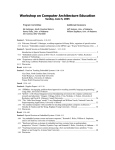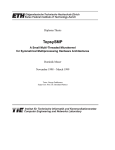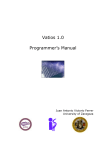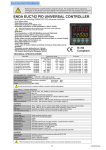Download - Digital Media Library - Rochester Institute of Technology
Transcript
Linux OS Emulator and an Application Binary Loader for a
High Performance Microarchitecture Simulator
by
Scott Charles Warner
A Thesis Submitted in Partial Fulfillment of the Requirements for the Degree of
Master of Science in Computer Engineering
Supervised by
Dr. Greg Semeraro
Department of Computer Engineering
Kate Gleason College of Engineering
Rochester Institute of Technology
Rochester, NY
June 2005
Approved By:
____________________________________________________________________________
Dr. Greg Semeraro
Primary Advisor – R.I.T. Dept. of Computer Engineering
____________________________________________________________________________
Dr. Roy Czernikowski
Secondary Advisor – R.I.T. Dept. of Computer Engineering
____________________________________________________________________________
Dr. Juan Carlos Cockburn
Secondary Advisor – R.I.T. Dept. of Computer Engineering
1
Thesis Release Permission Form
Rochester Institute of Technology
Kate Gleason College of Engineering
Title: Linux OS Emulator and an Application Binary Loader for a High
Performance Microarchitecture Simulator
I, Scott Charles Warner, hereby grant permission to the Wallace
Memorial Library to reproduce my thesis in whole or part.
_________________________________
Scott Charles Warner
_________________________________
Date
2
Dedication
To my wife Jodie and son Tyler whose support and encouragement made this possible.
Thank you also for understanding all of the late nights and weekends spend at work while
completing this thesis.
3
Acknowledgements
I would like to thank several people that have helped me through this process.
The first person I’d like to thank is my advisor, Dr. Greg Semeraro, for his guidance and
assistance throughout my thesis work. He was an invaluable resource throughout this
process, providing the concept of RITSim and the components required to realize it,
which provided the topic for this work, and the motivation, support and guidance to see it
through.
I would like to thank Dr Roy Czernikowski and Dr. Juan Carlos Cockburn for
their participation on my reading committee. Their input has helped to improve the
quality of this thesis document.
I would also like to thank Mr. Paul Mezzanini for his assistance configuring the
Linux machines to support aspects of the User Mode Linux work.
Finally I’d like to thank Ramesh Nagarajan and Theresa Bui, from Xerox, for
providing the support and flexible work schedule needed to accomplish this while
working full time.
4
Abstract
Simulation is a critical step in the development of state of the art microprocessors.
Accurate simulation allows designers to confidently investigate various designs, while
fast simulation times allow designers to thoroughly explore a design space. RITSim is an
endeavor to create a high accuracy, high quality mircoarchitecture simulation
infrastructure. This simulation infrastructure will be available for academic research in
low power and high performance computer systems.
The scope of this work is to provide a Linux OS Emulator, a Binary Application
Loader, and a Linux kernel running in a virtual environment for the RITSim project. In
order to evaluate standard software loads and benchmark suites on target
microarchitectures simulators must provide support for operating system calls. This may
be accomplished with various levels of accuracy. Many past simulators chose to sacrifice
simulation accuracy to improve simulation time, while others sacrificed portability and
execution time for high accuracy results. This work provides three key elements to the
RITSim environment in an effort to create a simulation environment that seamlessly
combines both approaches to provide a single integrated tool that allows researchers to
choose the approach that is best suited to their needs.
A first order simulation mode is provided that makes use of emulated system calls
that are executed on the host computer’s operating system to provide quick simulation
times. This mode also maintains a high level of portability since the host operating
system is used to access the hardware. A high accuracy mode is also available that runs
in a highly detailed simulated operating system. When running in the high accuracy mode
the simulated operating system must be loaded into a virtual environment allowing the
5
actual instructions of the operating system code to be simulated. Another key element is
the binary application loader. This is required by the simulator to load executables into
the simulator’s virtual memory space and to prepare it for execution. This involves not
only mapping or copying the executable into simulated virtual memory, but also the
creation and initialization of a new user mode stack and configuration of the simulated
processor’s user mode registers.
6
Table of Contents
Abstract _______________________________________________ 5
List of Figures__________________________________________ 9
Glossary______________________________________________ 10
Chapter 1 Introduction_________________________________ 11
Chapter 2 Thesis Objectives _____________________________ 13
2.1.
Motivation and Goals ......................................................................... 13
2.2.
Supporting work ................................................................................. 18
Chapter 3 Background on Existing Academic Solutions ______ 23
3.1.
System Call Emulation Based Simulators ........................................ 23
3.1.1
The SimpleScaler Environment ........................................................ 23
3.1.2
SimpleScaler Derived Simulators ..................................................... 26
3.1.3
Other Simulators ............................................................................... 29
3.2.
Binary Application Loader ................................................................ 30
3.2.1
The Linux Binary Loader.................................................................. 30
3.2.2
The SimpleScaler Binary Loader...................................................... 33
3.3.
Simulated Operating System Based Simulators............................... 35
3.3.1
The SimOS Simulation Environment ............................................... 36
3.3.2
The L-RSIM Simulation Environment ............................................. 37
7
Chapter 4 Design _____________________________________ 39
4.1.
System Call Interface Design ............................................................. 39
4.2.
The Binary Application Loader Design ............................................ 47
4.3.
The Linux Virtual Environment Design ........................................... 59
Chapter 5 Results _____________________________________ 62
5.1.
The Linux OS Emulator..................................................................... 62
5.2.
The Linux Binary Application Loader ............................................. 65
5.3.
The Virtual Linux Environment ....................................................... 67
Chapter 6 Discussion __________________________________ 71
6.1.
The Linux OS Emulator..................................................................... 71
6.2.
The Linux Binary Application Loader ............................................. 71
6.3.
The Virtual Linux Environment ....................................................... 72
Chapter 7 Summary and Future Work ____________________ 75
7.1.
Summary.............................................................................................. 75
7.2.
Future Work........................................................................................ 76
Bibliography __________________________________________ 78
8
List of Figures
Figure 1. System Call Proxy Class Diagram _________________________________ 44
Figure 2. Instruction Set Simulator class diagram ____________________________ 45
Figure 3. Sequence diagram for the read system call __________________________ 46
Figure 4. Bottom of the user mode stack ____________________________________ 53
Figure 5. BinaryLoader Class Diagram ____________________________________ 57
Figure 6. BinaryLoader Sequence Diagram _________________________________ 58
9
Glossary
RITSim
The Microachitecture, Power, Energy and Performance Simulator
developed at the Rochester Institute of Technology.
DEC
Digital Equipment Corporation.
GPL
The General Public License or the GNU General Public License.
TLB
Translation Lookup Buffer.
UML
User Mode Linux.
LSE
The Liberty Simulation Environment.
ISA
The Industry Standard Architecture Bus.
x86
This is a reference to the 386, 486, 586, etc. family of Intel processors.
ELF
The Executable and Linking Format.
a.out
The Assembler OUTput format.
COFF
The Common Object File Format.
ECOFF
The Extended Common Object File Format.
GCC
The GNU C and C++ compiler.
GNU
A recursive acronym for “GNU’s Not Unix” .
bss
Defines a storage area in the data segment that holds un-initialized data.
rc.local
A script provided in the Linux kernel boot structure that is used to define
custom initialization instructions.
PISA
Pendulum Instruction Set Architecture
10
Chapter 1
Introduction
RITSim is an endeavor to create a high accuracy, high quality mircoarchitecture
simulation infrastructure. The intended use for this simulation infrastructure is for use in
academic research in low power and high performance computer systems.
To be
effective, modern microarchitecure research requires a simulator that is accurate enough
to show the effects of minor design changes. This is driven by the difficulty in obtaining
performance gains in microachitectures. In an effort to keep advancing performance
gains researchers are required to use either exotic solutions or a complementary minor
design changes. To achieve this researchers need a simulation tool that will correctly
simulate the effects of these minor changes.
To drive this research the RITSim
environment will provide an integrated simulation environment that combines accurate
system simulation with an accurate microarchitectural simulation. This combination
provides highly accurate simulation results giving researchers the information needed to
study the impact of minor design changes.
One of the unique aspects of RITSim is that it combines a quick, first order
simulator, with a highly accurate, full system simulator seamlessly integrated within the
same environment. This work will cover three key elements of this environment. The
first component is an emulated operating system. This is provided to meet the quick first
order simulator goal. Operating system emulator based simulators are an ideal way to
provide quick simulation times. The reason for this is that the simulator actually executes
the system calls on the host machine instead of simulating them. The drawback to this
11
approach is reduced accuracy. Since these system calls are executed outside of the
simulation environment the simulator does not incorporate the effects of the operating
system on the application.
This is acceptable though for a high-speed first order
simulation. To give researchers the freedom to run a large set of applications in the
simulator the Linux [16] OS emulator provides emulation support for nearly all of the
Linux system calls. Past simulators provided limited system call support, limiting the
number of programs that may be executed within that environment.
Providing the
support needed to execute any application is very important as researchers attempt to
understand the impact of modern software designs on microarchtecure.
The next aspect of this work adds the support of a high accuracy, full system
simulation mode. To obtain the best simulation results, the simulation environment must
support a full system simulation. This requires an operating system running in a virtual
environment.
Since the operating system runs in a virtual environment, the operating
system calls fall within the scope of the simulation environment.
The final feature is a binary application loader that is used to load executables into
simulated memory space. This feature is required to load the application into simulated
virtual memory space and prepare it for execution by the target processor.
12
Chapter 2
2.1.
Thesis Objectives
Motivation and Goals
Computer architecture researchers rely heavily on simulations to drive new
microprocessor designs. The time and monetary costs associated with the construction of
a hardware prototype are simply too prohibitive to justify without first evaluating new
ideas with thorough simulation [9]. Simulation tools also play an important role in
research work where the end goal may not be to create a physical microprocessor. These
tools allow researchers to probe new ideas to increase their knowledge of
microprocessors and explore advanced ideas and designs.
There are two main types of simulators. Simulators such as SimpleScaler [5] and
RSIM [12] provide an emulated operating system where system calls are converted from
the simulated call to a call that is executed on the host. While offering quick execution
times and a high level of portability these simulators suffer in terms of accuracy. This is
due to the fact that system calls are executed on the host computer not inside the
simulation environment thereby overlooking the importance of the operating system [13].
The result of this approach may lead to inaccurate or misleading simulation results,
especially for operating system intensive operations. Consider database applications that
rely heavily on the scheduling of multiple processes and file system accesses both of
which are the responsibility of the operating system.
An investigation of database
transaction activity revealed that close to 40% of its execution time is spent in the
operating system [10]. Web server applications represent another set of operating system
intensive applications. These applications make extensive use of the network services,
13
file system accesses, and significant scheduling load to service multiple requests all of
which are provided by the operating system.
An experiment that ran a Webstone
benchmark test on a Zeus server reported more than 70% of the execution time occurred
in the operating system [10]. This disconnect with the operating system may lead the
researcher to draw inaccurate conclusions. The danger is that an interesting new design
may be overlooked. The opposing case would be the prototyping of a promising new
design, only to find that in was a substandard design during physical testing.
Clearly high accuracy simulation results are a key goal for a new simulation tool.
High levels of accuracy are offered by simulation tools such as SimOS [10] and L_RSIM
[11].
These tools offer substantially more accurate results by simulating the operation
system.
While increasing accuracy these approaches also dramatically increase the
simulation time. Often processor models are simplified to alleviate the simulation time
penalty.
The result is a simulation environment that produces accurate results for
operating system intensive applications, but fails to simulate the intricate interactions
with a modern microarchitecture [11]. An additional drawback is the lack of portability.
This type of simulation environment is created for a specific target architecture, operating
system and simulation environment. These effects contribute to code that is not portable.
An example would be attempts to extend the popular SimOS [10]. SimOS [10] was
developed at Stanford to simulate the Flash [17] multiprocessor. Attempts have been
made to extend this simulator to support Alpha [18], PowerPC [19], x86 [20] and SPARC
[21] architectures. Only two of these ports were successfully completed. The Alpha [18]
port was completed by Western Research Laboratory (formerly Digital Equipment
Corporation, DEC). The Alpha [18] architecture has similarities with the MIPS [22]
14
architecture, which the Flash [17] architecture was based on, helping to reduce the
complexity of the Alpha [18] extension.
The Austin Research Lab completed the
PowerPC [19] port. It is important to note that large research labs completed the two
successful ports. Attempts to extend the simulator to support the x86 [20] and the
SPARC [21] architecture have failed [23]. Clearly the tightly coupled target architecture,
operating system and simulation environment contribute to create an environment that
severely impacts portability and code reuse.
The Microarchitectual, Power, Energy and Performance Simulator (RITSim)
project will improve upon prior simulator approaches to provide a single environment
that provides a highly accurate microarchitecture simulator for low-power and high
performance microprocessors that will be available to the academic environment.
Simulating the operating system in SystemC will provide high accuracy. A parallel
simulation environment will be utilized to increase the performance of the simulated
operating system. Inclusion of an emulated operating system will allow quick first order
simulations as well as maintain a high level of portability.
The topic of this thesis is to provide the emulated operating system, binary loader
and virtual environment from which the simulated operating system is run within the
scope of RITSim. Linux is a widely used operating system available under the General
Public License (GPL) that runs on many of today’s microprocessors, making it an
excellent choice for academic use. The GPL allows for free distribution and access to
source code, both of these are vitally important within the scope of this project. Another
benefit is that it’s a standard operating system widely used in the academic environment
alleviating the need to learn a new operating system when using this simulator.
15
There are two parts to the Linux OS Emulation tool. The first is to provide a
mechanism to handle intercepted system calls. In Linux, system calls are issued to the
Kernel by the User Mode processes to access hardware devices.
This provides an
abstraction layer between the user and the hardware that the operating system is running
on [1]. This is typically referred to as a system call by proxy method. When the user
program executes a system call the simulator traps it and sends it to a system call proxy
where the call is converted to a system call that is executed by the host operating system.
When the host system finishes executing the system call, the results are repacked and sent
back to the simulator. The goal for the interface to this proxy is to provide an approach
that is extensible, allowing for future expansion. An example of this may involve using
base classes, with derived classes that contain the pertinent data structures.
The binary loader will be responsible for allocating the necessary system memory,
transferring the binary files to that memory, and setting any necessary instruction pointers
or other registers required to allow the code to execute. There are many applications that
need to load Linux binary executables. Selection of the best mechanism for our use
involves studying what other applications, such as User Mode Linux, do to provide this
service.
A virtual environment will be provided to load and execute the simulated
operating system. An existing software package, User Mode Linux (UML), provides a
good starting point for this feature. UML creates a virtual Linux machine that runs on
top of the host machines Linux kernel. This has been used very successfully in the past
for testing new Linux Kernels [8]. Furthermore the UML kernel code is executed within
the simulation environment so the effects of the system calls are seen within the
16
simulator. For example, cache and TLB pollution effects due to the kernel code and the
effects of context switching would be seen and the impact of these events would be
measurable in the simulator. Other avenues were explored prior to making the final
decision. Existing simulators that feature simulated operating systems, such as L-RSIM
[11] and SimOS [10], were studied in an effort to select the best approach.
The operating system that was selected was Linux. Linux is a very popular
operating system in the academic environment due in large part to the fact that is a freely
distributed, open source operating system.
The clear advantage of this is the low
acquistion cost, but perhaps the most important aspect is that it gives developers access to
the source code. This gives researchers the freedom to modify parts of the operating
system to fit their needs. An example would be modification of the existing scheduling
routine to optimize if for real-time operations. Another benefit for RITSim is the large
number of existing software applications available for Linux. This gives the researcher
the ability to run a wide range of programs on the target architecture instead of limiting it
to a few test suites. Other simulation environments such as L-RSIM [11] used a custom
operating system. This approach simplifies the simulation environment since only the
functionally needed by the simulator is provided. The two main drawbacks to this
approach are the unfamiliarity of new developers with the custom operating system and
the poor correlation between the simulation operating system and the operating system
used on an actual machine.
17
2.2.
Supporting work
The majority of recent papers published have relied on the simulation results
achieved from the freely distributed simulation tools that include SimpleScaler [5], Rsim
[12], and SimOS [10]. Each of these simulators supports either system call emulation or
simulated operating systems.
SimpleScaler [5], in development since 1994, is a widely used simulation tool in
academia. SimpleScaler is an architectural, execution-driven simulator. Architectural
simulators are a category of simulators that implement the high level architecture, as
opposed to simulators that implement the highly detailed, low-level microarchitecture.
Architectural simulators are generally faster and more portable, but offer less accurate
simulation results.
Execution-driven simulators are simulators that execute the
simulation program and generate the simulation stream dynamically. The complement to
execution-driven simulator is trace-driven simulation, which reads the trace of an
instruction saved from the previous execution. Trace-driven simulations are simpler to
write since there are no functional components and no feedback from the trace. Perhaps
the biggest drawback to trace-driven simulation is the loss of accuracy because they are
not able to provide feedback on speculative results that are supported by superscaler
processors [15].
SimpleScaler falls under the category of simulators that emulate system calls. A
proxy handler intercepts system calls coming from the simulator, converts them to a
system call that can be executed on the host processor, executes the call and copies the
results of the call back to the simulated program’s memory [5]. It is here that the
disconnect with the operating system is realized, since all system calls are handled
18
outside the simulator. This approach has its advantages however, two of which are
execution time and portability. Since the system calls are executed by the host hardware,
instead of simulated hardware they execute much quicker. Portability is also maintained
by relying on the host processor’s system calls; the simulator is unconcerned with the
underlying hardware of the system. This approach is not completely free of portability
issues though, moving this simulator from one operating system to another will require
modification of the system call translator to correctly map to the host operating system’s
system calls. Another drawback to this particular implementation is the lack of support
for all system calls in Linux. This limits the number of applications that can be executed
in this simulator. The Linux OS Emulator will provide the option to use emulated system
calls similar to SimpleScaler to maintain the benefit of quick execution time and
portability. In addition to this all Linux system calls will be emulated, this will allow the
simulator to execute any Linux program.
SimpleScaler [5] includes different simulation programs that provide increasing
levels of simulation detail. At the fast execution end are sim-fast and sim-safe. These are
optimized for simulation speed and cannot be used to perform microarchitectural
simulations.
These simulation programs simply execute instructions on a simulated
machine with no architectural features. Essentially these simulators simply verify that
the instruction set simulator is working correctly. It may also be used by individuals who
want to add instructions to the machine, modify a compiler and verify that the program
still functions correctly. Sim-fast is the quickest, while sim-safe adds some memory
operation safe guards. This makes sim-safe useful for debugging sim-fast. Sim-EIO is
also a fast executing simulation similar to sim-fast and sim-safe, but adds external trace
19
and generator capabilities. Sim-profile falls somewhere in the middle; the main benefit
of this simulator is that it profiles by symbol and address. It provides reports on many
simulation results including dynamic instruction count, instruction class counts, usage of
address modes, etc. The sim-cache/sim-bpred models provide fast simulations for cache
miss and miss-prediction rates, however it offers no timing impact. Sim-outorder is the
most detailed simulator that supports an out-of-order execution core, speculative
execution, a 2-level cache and branch prediction. Of course being the most detailed it
also has the slowest execution time. A source of confusion when using the different
simulations is that the simulation results rarely agree. For example, cache statistics from
sim-cache differ from the same statistics generated by sim-outorder bringing into
question the accuracy of either set of results.
Another execution-driven simulator RSIM [12] from Rice University was created
to research shared memory multiprocessors that exploit instruction-level parallelism
(ILP). Developed in 1997 this simulator improved on contemporary simulators, such as
SimpleScaler, by providing a more detailed processor model. Simpler processor models
may be used to increase simulation performance, again at the cost of accuracy. These
simpler models did not do an adequate job of simulating ILP processors [12]. Under
some conditions RSIM provides very accurate results, however this simulator does not
simulate the operating system. Once again operating system intensive workloads will not
be accurately simulated.
SimOS [10] was developed to address the inaccuracies associated with neglecting
the impact of operating system activities on simulation accuracy. By providing fullsystem simulation capabilities simulation accuracy is dramatically increased for operating
20
system intensive applications. Another benefit to simulating the entire machine is that it
is capable of booting and running a fully functional operating system and any application
that runs on that operating system. The downside to this approach is that simulating the
entire system takes a lot of time. This was addressed by providing three levels of
simulation speed through the use of simulation models that vary in the level of detail.
While being a valuable simulation tool it has its limitations. The processor and cache
models are simplified limiting the simulated accuracy of the complex interactions of
modern microarchitectures [11]. Due to its lack of support for complicated processor and
cache models, SimOS is best used as a system level simulation environment, as opposed
to a processor architecture simulation environment. RITSim will offer detailed processor
and cache models with the added benefit of a simulated operating system making it a
simulation tool that is much more useful for simulating modern processor architectures.
L-RSIM [11] was a further refinement to existing simulation tools. In an effort to
create a simulation environment with high accuracy models and operating system
simulation support it combined the highly detailed processor model of RSIM with a
simulated operating system and simulated I/O device behavior. To simplify the task of
simulating an operating system a hybrid operating system, LAMIX [11], was created.
This operating system was specifically targeted at file system and disk I/O operations
thereby simplifying the implementation when compared to simulating a complete existing
operating system such as Linux. This simulator showed an excellent correlation between
simulated and actual results obtained from a SGI Octane workstation for architectural
performance parameters such as memory performance and disk seek times [11]. The
operating system performance, however, did not correlate well indicating that while using
21
a non-standard operating system simplified the simulator development it also negatively
affected simulation results. This simulation tool provides an indication of the highly
accurate simulation results that are possible when a simulated operating system is
coupled with highly detailed processor and cache models. This work will take this one
step further by supporting a standard operating system to improve simulation accuracy.
The Liberty Simulation Environment (LSE) [4] represents the most recent
simulation tool in the academic environment. This simulation environment addresses the
disconnect between hardware mapping and the software models used to simulate them. It
provides a set of resources that automatically generate software models based on the
hardware description, thereby maintaining the accuracy of the model. To allow these
models to be automatically generated a set of well-defined interfaces were defined for the
communication between models. One benefit of the consistent communication protocol
between models is the increased portability. It also creates a set of flexible reusable
components that are relatively easy to reconfigure to support different architectures. LSE
is not is a simulator, but an environment that is used to create a simulator whose goal is
solve the hardware mapping to software model consistency issue, which falls outside the
scope of this work.
The Linux OS Emulation tool within the scope of RITSim will provide a single
environment that incorporates many of the desirable features of past simulation tools.
This is accomplished by using a standard operating system with an emulation mode that
will provide fast simulation times and provide portability coupled with a simulated
operating system that provides increased simulation accuracy for operating system
intensive applications.
22
Chapter 3
3.1.
Background on Existing Academic Solutions
System Call Emulation Based Simulators
While there are many simulation environments currently available, one of the
most widely used simulators is SimpleScaler [5]. This chapter begins with a detailed
description of how the system calls are simulated, and then moves on to look at some
other relevant simulators.
3.1.1 The SimpleScaler Environment
The following is a detailed description of how SimpleScaler [5] handles simulated
system calls. A system call proxy is used to convert simulated (target machine) system
calls to system calls that are executed on the host machine. System calls are emulated by
the following sequence:
1.
Decode the system call. This is represented by an enumeration that
corresponds to a system call.
2.
Copy system call inputs from target memory to host memory prior to
execution on the host.
The amount of memory varies by system call.
For
example, in Linux, the sys_read() call will need to allocate an area the size of
the file that is to be read in. Additionally the input variables are copied to the
correct registers for the host machine. Again this varies by system call, in Linux
the sys_exit() call only takes one input variable while the sys_select() call
takes six input variables.
3.
Execute the system call on the host machine.
23
4.
Copy the system call results from host memory to target memory. For
example if sys_read() was executed the results need to be copied from the host
buffer into simulator memory space.
5.
Set target result register to indicate successful completion or the error status
of the system call. Set any other registers that are affected by the result of the
system call.
The sys_syscall() function is the call used to execute an emulated system call via the
system call proxy. It is defined as follows:
void sys_syscall(struct regs_t *regs,
/* registers to access */
mem_access_fn mem_fn, /* generic memory accessor */
struct mem_t *mem,
/* memory space to access */
md_inst_t inst,
/* system call inst */
int traceable);
/* traceable system call? */
The regs_t structure represents the registers that are used for this system call. This
structure is shown below:
struct regs_t {
md_gpr_t regs_R;
/* (signed) integer register file */
md_fpr_t regs_F;
/* floating point register file */
md_ctrl_t regs_C;
/* control register file */
md_addr_t regs_PC;
/* program counter */
md_addr_t regs_NPC;
/* next-cycle program counter */
};
The mem_access_fn accessor is used to access the simulated virtual memory space. It is
defined below:
24
typedef enum md_fault_type
(*mem_access_fn)
(struct mem_t *mem,
/* memory space to access */
enum mem_cmd cmd,
/* Read or Write */
md_addr_t addr,
/* target memory address to access */
void *p,
/* where to copy to/from */
int nbytes);
/* transfer length in bytes */
The mem_t structure represents the memory space that is accessed. This structure is
defined below:
struct mem_t {
/* memory object state */
char *name;
/* name of this memory space */
struct mem_pte_t *ptab[MEM_PTAB_SIZE];/* inverted page table */
/* memory object stats */
counter_t page_count;
/* total number of pages allocated */
counter_t ptab_misses;
/* total first level page tbl misses */
counter_t ptab_accesses; /* total page table accesses */
};
The md_inst_t value is a little misleading, this value does represent a system call
number but it is used only for debug, the actual enumeration that represents the system
call that will be executed is in the global variable that represents the V0 register (for the
Alpha architecture). This illustrates one of the difficulties associated with modifying
SimpleScaler[5], the use of global variables to store the register values for the system
calls makes it very difficult to trace the call through the code.
25
The design for this thesis work will make use of the basic sequence used by
SimpleScaler [5].
This is a good proven approach, however, there is room for
improvement. One area is the method used to map the target register set to the host
system call parameters.
With SimpleScaler[5] the registers used in the system call
emulator are tied directly to a particular ISA. This makes it necessary to rewrite this code
for each ISA, an example of this would be separate sets of source code to handle Alpha
and PISA architectures. For this work a layer of abstraction will be added to enable the
use of a single system call emulator for various ISAs, the instruction set simulator
changes, but the system call emulation should not. An additional improvement is the
emulation of all of the system calls, which gives a researcher the freedom to execute a
wide range of programs, instead of limiting them to a particular test suite. Other design
details of the SimpleScaler environment that will be avoided are the use of global
variables and macros. The use of these significantly degrades readability and reuse, both
of which are important goals for this work. Finally, the interface used to copy data
between the simulator and host memory will be simplified.
3.1.2 SimpleScaler Derived Simulators
Being a widely used simulation environment that is freely distributed other
simulators such as The Simulator for Multithreaded Computer Architecture, SIMCA [24],
and SIMCORE [25] have made use of SimpleScaler [5] to varying degrees. There are
two approaches to creating a simulation tool, modifying one that exists, or creating one
from scratch. The benefit of modifying an existing simulation tool is the time saved by
not having to create the entire environment from scratch. The drawback is the difficulty
26
involved in modifying the existing tools without introducing errors.
Many existing
simulation tools, such as SimpleScaler [5], whether through the extensive use of global
variables and/or macros, are difficult to extend. Many academic simulation tools did not
start with the goal of providing a flexible, modular environment. In order to modify such
code without introducing errors one must fully understand its internal details, which is
often a nontrivial task due to difficulties in understanding someone else’s code and
limited documentation [26].
One of the benefits of creating a new simulation
environment is that is allows the developer to draw from past implementations to create
the best possible environment for the target application. The main drawback to this
approach is the time needed to create all of the tools.
This section examines two
simulators, one that added a layer on top of SimpleScaler [5] to achieve the desired
simulation support, and another that rewrote an improved simulation environment based
on SimpleScaler [5].
SIMCA [24] was developed at the University of Minnesota; it is a simulator
targeted at simulating super-threaded architectures. In an effort to speed up the
development time of the simulation environment the simulator was implemented on top
of a SimpleScaler Release 2.0 [5] simulator. This approach used a technique called
process-pipelining to place a layer on top of the existing SimpleScaler simulator. It
allowed them to extended SimpleScaler to support multithreaded simulations.
This
approach was used in an effort to minimize development time by leveraging existing
software. The penalty for this approach though was that simulations were 3.8 to 4.9
times slower [26]. While this shows that it is possible to make use of existing simulators
27
to speed development time, the resulting simulation environment will not operate at
optimal speeds.
SIMCORE [25] is a simulation environment developed at The University of
Electro-Communications in Tokyo, Japan. The primary intent of this simulator was to
provide a tool for academic education and research. The simulation functionality of
SIMCORE [25] is similar to the sim-fast simulation in the SimpleScaler toolset [5]. This
simulation is optimized for fast simulation speeds and enhanced readability compared to
SimpleScaler [25]. This makes it a great tool for education since results may be obtained
quickly. Use as a research tool is limited, however, since it is optimized for speed over
high accuracy. It makes use of the sim-safe/sim-fast simulations from SimpleScaler [5],
which cannot simulate the impact of architectural changes directly. In SimpleScaler[5]
the architectural changes must be simulated using sim-outorder to verify the performance
impact of those changes. Furthermore, examination of the system call emulator code
revealed that the simulation environment only implements the system calls needed to run
the SPEC CPU2000 test suite, further reducing its usefulness as a research tool.
SIMCORE [25] improves on SimpleScaler [5] by, among other things, removing
global variables and macros to improving readability. A single class holds all of the
information needed to perform an instruction. It was discovered, however, that while
offering improvements in some areas, it still relies on SimpleScaler [5]. The binary
application loader uses a modified version of the SimpleScaler [5] loader and verification
is performed using SimpleScaler[5] sim-safe simulations.
Clearly it’s an unsuitable tool for in-depth research, but there are some good
points about SIMCORE [25] that will parallel the approach used in this work. The first
28
of which is the use of C++ to improve reuse through abstraction layers. The second is
improved readability by removal of global variables and macros.
3.1.3 Other Simulators
A very popular x86 emulator is BOCHS [27]. It simulates an entire x86 based
system allowing x86 software to be run without modification on any host machine. The
main purpose of this tool is to allow a person to run an x86 operating system (Windows,
Linux, etc.) and software on a non-native host system. Even though this emulator is not
targeted at architectural research the system call emulation method was examined as an
additional approach to emulating system calls. The approach that is used in this emulator
is to create a virtual environment for the emulated operating system. As the emulated
operating system makes calls to a particular hardware driver to perform an action on the
hardware, the driver converts the emulated system call to the host system call and
invokes it on the host hardware. An example of this would be a call to the CDROM
driver to spin up the drive, the CDROM driver would convert the ioctl call used to spin
up the drive to the host specific call and execute the converted system call on the host
operating system, which in turn spins up the CDROM on the host machine. The way
various host operating systems are supported is the use of #ifdef statements surrounding
system calls to check for the host operating system. The use of all of the #ifdef, #elif
statements leads to poor readability. However, the biggest drawback to this approach is
the large number of driver files that must be modified to support new host operating
systems. Every driver file must be modified wherever there is a system call to support
the new system calls. This approach will not be used for RITSim.
29
As discussed in section 2.2 RSIM [12] is another popular simulation tool. RSIM
[12] emulates some system calls, such as read and write, and simulates other system calls
at the CPU level. The emulated system calls are relevant to this section and shall be
discussed here. RSIM uses a class to trap the system calls; these calls are then passed to
a proxy class that decodes the call and handles the emulation. The emulation is typical of
other examples that have been examined, where the target system call is converted to
execute on the host machine. The write system call, for example, copies the buffer data
associated with the write command to a local buffer, extracts the register values
associated with the emulated call converts them to the host system call parameters, makes
the system call on the host machine, and returns the return status of the host based system
call. The steps used to emulate the calls are similar to the ones that will be used for this
work, but the design of the RSIM emulation does not readily support emulation of
different architectures since it still relies on specific register mappings.
3.2.
Binary Application Loader
The binary application loader section will examine the mechanisms present in
Linux that are used to load an executable binary file and prepare it for execution. This
will be followed by a look at the mechanisms used by SimpleScaler to load the simulated
programs.
3.2.1 The Linux Binary Loader
In Linux the execve() function is used to replace the execution context of a
process with the new context contained in an executable file [1]. Part of this process is
30
loading the executable binary file and configuring the stack to prepare for execution.
This is handled by the load_binary() function.
Linux supports many executable
formats, such as Executable and Linking Format (ELF), Assembler OUTput Format
(a.out), MS-DOS EXE programs, BSD Unix’s COFF executables, etc. To correctly
interpret and load each of these different formats there are different versions of the
load_binary()
function, each tailored to the target executable.
load_elf_binary()
For example the
function is called to load the ELF executable. For the purpose of
this work only the ELF format will be supported. ELF was selected because it is the
current standard Linux executable format. An additional benefit is that it is an extremely
popular format for Unix systems [1].
The load_binary() function is responsible for loading the executable binary
code and configuring the stack.
Since RITSim will only use the ELF format the
following analysis is based on the load_elf_binary() function. This method executes
approximately twenty-one steps to load an application that was compiled using dynamic
library linking. For RITSim the loader will only support executables that were compiled
with statically linked libraries. One very important aspect of a simulation environment is
producing consistent results. Achieving this goal requires the use of statically linked
libraries. Since all of the libraries are included in the executable, the simulation may be
rerun at any time with the knowledge that no libraries were modified from one run to the
next. A benefit of this requirement is a significant decrease in the number of steps
required to load the executable. A major simplification presented by loading statically
linked libraries is that the loader does not need to search for the shared library and the
interpreter needed to execute it. Keep in mind that a dynamically linked ELF file may
31
link to executables of a different format. For instance an ELF executable may contain a
dynamic link to an a.out library. To support this the loader must also load an interpreter
for a.out executables.
load_elf()
The following discussion describes the process used by the
method to load a statically linked ELF executable.
The load_elf() function reads the header of the executable file and performs
consistency checks on the magic numbers. If the executable does not satisfy the loader’s
requirements an error of -ENOEXEC is returned.
If it is an acceptable executable file the program header information must be
interpreted, these headers contain the information about the program segments and the
shared library information. For RITSim the shared library information is an indication
that the executable contains dynamically linked libraries, which is a failure case.
After the segment information has been obtained the flush_old_exec() function
is called. This function removes all traces of the currently running executable. The
PF_FORKNOEXEC
flag is then set in the process descriptor. This flag is used to track
processes and is set when a process is forked and cleared when it executes a new
program.
This is followed by a call to setup_arg_pages().
This function allocates
memory for the new process’s user mode stack and inserts the memory region in the
process’s address space.
It then assigns page frames containing the command line
arguments and environment variable strings to this address space, so they can be copied
to the new user mode stack.
The text and data segments are then mapped with the do_mmap() function. This
creates a new memory region that the text segment and data segment of the executable
32
are mapped to. The un-initialized data section (bss), which follows the data segment, is
then mapped using the do_brk() function.
The start_code, end_code, start_data, end_data, start_brk, brk
(although inconsistent the name is brk, not end_brk), start_stack, env_start,
env_end, arg_start
and arg_end fields of the process’s current memory descriptor
are then updated.
Finally, the start_thread() macro is called to modify the user mode register
eip
to point to the execution starting point and the user mode register esp to point to the
top of the new User Mode stack. At this point the process is ready to begin execution.
For the RITSim binary application loader the sequence should be similar. The exception
being the use of simulated virtual memory as the target for loading the executable,
containing the user mode stack, and simulated user mode registers.
3.2.2 The SimpleScaler Binary Loader
SimpleScaler [5] provides various routines to load executable files into simulated
virtual memory space. There is support, via separate files, for the two main architectures
supported by SimpleScaler[5], Alpha and PISA. Both of these implementations support
binary loading using the Binary File Descriptor Library (BFD) or native Extended
Common Object File Format (ECOFF) access methods. The BFD is a library that
provides a single interface to read and write object files, executables, archive files, and
core files in any format. The benefit of the BFD library is that it provides a set of
methods to gain information about an executable through a common interface for
different executable formats. There is a compile time flag that needs to be set in the
33
makefile to direct the loader to use the BFD libraries, if not defined, the loader reverts to
the native ECOFF format. While the individual commands used to gather information
about the executable differ from those used for ELF executables, the overall process of
loading the executable and preparing for execution is quite similar.
The purpose of the SimpleScaler[5] loader function is to load the program text
and the initialized data into simulated virtual memory space and to configure the program
segment range variables to prepare for execution. This process varies slightly depending
on whether the BFD loader is enabled or if the file is loaded using the native ECOFF
functions.
If the BFD loader was enabled, the loader process begins by opening the
executable file and checking for the correct file and endian format. If the formats are
correct the file is read into memory. At this point all of the section headers are read, any
section that is allocated, loadable and not NULL are read into a buffer. After all
sections have been stored in the buffer it is copied into simulated virtual memory. If the
section is loadable but not allowed to execute it is determined to be the bss section. To
handle the bss section the loader creates a buffer of the bss size and zeros all of the
values, then copies this to simulated virtual memory.
With the sections stored in
simulated virtual memory, the loader examines each section name to identify the text and
data segments. Upon identification the header information is used to determine the
location and size of each segment.
From this point on the implementation is the same for both the BFD loader and
the native ECOFF loader. The final steps involve simple sanity checks on the text and
data segments to make sure they were actually found in the executable. The stack pointer
is then setup. The agrc value is copied onto the stack then the argv array pointer and the
34
argv
array followed by the envp pointer and the envp array. Finally the stack and
instruction pointers are set for the target processor and the program counter register is set
with the program entry point.
The portion that loads the executable using the native ECOFF methods begins by
reading the executable into memory. This implementation differs from the BFD Loader
by verifying the endian and executable format after the file is read into memory. The
start and size of the text and data segments are read from the ECOFF header. When the
text and data segments are located they are stored in a local buffer then copied into
simulated virtual memory space.
After the text and data segments are copied into
simulated virtual memory space, the process continues as above with the initialization of
stack and processor registers.
The SimpleScaler [5] binary loader process is similar to the Linux binary loader.
The most significant difference is the need to copy the executable into simulated virtual
memory space. This will be the same for the RITSim loader.
The general sequence used by both loaders is to evaluate the header to verify that
the executable meets the loader’s requirements. Then copy or map in the text, and data
sections. Followed by copying the envp, argv, argc variables to the stack. Finally the
processor registers must be set with the new stack pointer and instruction pointer. This is
the same sequence that will be used on the RITSim binary application loader.
3.3.
Simulated Operating System Based Simulators
Simulators that support a fully simulated operating system are necessary to obtain
the most precise timing measurements. This is especially true when running simulations
35
with applications that are operating system intensive, such as database or web-server
applications. As discussed in the supporting work section SimOS [10] and L-RSIM [11]
are two academic simulation environments that provide simulated operating systems.
This section takes a closer look at these two approaches
3.3.1 The SimOS Simulation Environment
SimOS [10] attempts to simulate an entire machine.
The simulation time
associated with simulating an entire machine or system is extensive. To combat this
SimOS provide three simulation levels. The first level is called the positioning mode,
which provides the fastest simulation times with the least accuracy. It is a very useful
mode to run to gain initial results quickly. The next level is called rough characterization
mode and is a compromise between fast simulation speed and accurate simulation results
and is a good intermediate step to narrow down a design. The final level is accurate
mode, which provides the most accurate results at the expense of simulation times.
Different device models are used for the each of the simulation levels, however
even in the most accurate mode the processor and cache models are very basic. For
instance there are two processor models implemented for the accurate mode. The first is
the Mipsy processor. This models a simple single-issue pipeline processor, which uses a
straightforward fetch-decode-execute loop [10]. To speed up execution times this model
simply charges a fixed latency for each instruction instead of modeling the processor
pipeline.
Thus limiting the use of this model for in-depth processor architecture
investigations.
A second more detailed processor model is supplied. The MXS model uses the
same fetch-decode-execute loop as Mipsy, but also offers more detailed modeling typical
36
of a modern superscalar processor. While this model provides more detail, the data it
generates is targeted at overall system level performance. This again limits its usefulness
for detailed processor architecture investigations.
While targeted as a system simulation tool, SimOS has significant limitations
when used as a processor simulation tool. In contrast, by providing a simulated operating
system combined with detailed processor and cache models RITSim will provide a
simulation environment that is conducive to in-depth processor architecture
investigations.
3.3.2 The L-RSIM Simulation Environment
As discussed in the supporting work section, L-RSIM [11] is a simulation tool
that is an extension to RSIM [12].
The purpose of this simulator was to provide
increased simulation accuracy by adding a simulated operating system. This approach
coupled the highly detailed ILP processor model from the RSIM [12] environment to a
simulated operating system. The goal was to improve the accuracy of simulations that
ran operating system intensive applications. While it provides a simulated operating
system, the actual simulated operating system proves to be a weakness. To avoid the
complexity of porting an existing operating system to the simulation environment a
simplified operating system was used. This custom operating system was targeted at file
system and disk I/O. Verification of this simulator demonstrated accuracy improvements
over RSIM [12] for file and disk I/O interactions. There was, however, a poor correlation
for operating system performance between the simulator and an SGI workstation that it
was verified against.
37
Although the use of a simplified operating system simplified the simulator
implementation and showed some good performance correlations, the best results would
be obtained from simulating a standard operating system. Of importance is that this
approach does demonstrate the benefit of incorporating a simulated operating system in
the simulation environment. The next logical step would be the inclusion of a standard
operating system within the simulation environment. This was addressed by the use of
Linux as the simulated operating system provided by RITSim.
Due to the shortcomings of the existing solutions RITSim will make use of an
existing application, User Mode Linux, to provide a Linux kernel running within a virtual
environment. User Mode Linux is actually a patch that is applied to a Linux kernel. This
patch to the kernel produces an application that loads a full Linux operating system into a
virtual environment that is run on top of the Linux kernel on the host machine. The
primary use for this is to test new kernel versions, debug new software, kernel
experimentation, etc. User Mode Linux is ideal for this type of work since it is run in a
virtual environment, where all of the resources are contained within a single file system
on the disk. When running applications from within User Mode Linux nothing outside of
this file may be touched, therefore eliminating the risk of damaging the kernel on the
physical system.
Some of the latest uses of this have involved testing network
applications over complex networks all within a single physical machine. Eliminating
the cost and time involved in configuring multiple machines to perform the same testing.
Within the scope of this work User Mode Linux will be used to provide a standard
operating system, Linux, loaded into a virtual environment that provides the base for a
fully simulated operating system.
38
Chapter 4
4.1.
Design
System Call Interface Design
A
new
system
call
interface
was
designed
drawing
from
previous
implementations such as SimpleScaler [5], RSIM [12], and SIMCORE [24]. The goal
was to create an efficient, readable and easily expandable interface. Linux system calls,
when run on an x86 platform, may use up to six registers to store parameters. To execute
a system call, the integer value representing a system call is placed in register eax, any
other registers needed to execute the system call are then loaded with the correct value.
When the required registers have been correctly set the system call is initiated by calling
the software interrupt 0x80. For example, the sys_read() call is run by programming
the eax register with the system call index associated with the sys_read() call of 0x3,
ebx
is programmed with the file descriptor, ecx is programmed with the character buffer
pointer, and edx is programmed with the file size. Following the completion of the
system call an integer value is passed back in eax that contains the completion code, and
the character buffer has the data that was read in with the sys_read() call. In RITSim
the target system call will be captured by the instruction set simulator.
It is also
responsible for capturing the register values for the target architecture and invoking the
emulated system call method.
To support the emulated system calls a set of registers will be needed to store the
required system call parameters. Simulators such as SimpleScaler [5] and SIMCORE
[24] use generic register descriptors such as r[0], r[1], etc. This approach provides a
small level of abstraction since it is independent of the actual register name that is
39
associated with different architectures. This approach, however, does not allow the target
architecture to change without extensive modification to handle the varying register sets
used in differing architectures. Although the register names are abstract, the meaning of
these registers are still hard coded to a specific architecture. For example, for the Alpha
architecture, r[16] is the register that holds the file descriptor for the read operation. So
the system call proxy extracts the value in r[16] to get the file descriptor, this is fine for
an Alpha architecture, but any architecture that uses a different register to store this value
will be incorrect. Clearly the system call proxy will need significant rework to function
correctly with different architectures. This important aspect was addressed by providing
a parent register class that is used by the system call proxy and child register classes that
are used by the instruction set simulator to convert from the target register set to a generic
register set that will be used by the system call proxy. The effect of this is an emulator
that will run different architectures without modification. The instruction set simulator
will correctly map the target registers to the register sets needed by the system call
through accessor methods defined in the parent register class. The child class will
provide the concrete implementations of the accessor methods to provide the correct
mapping from the target architecture to the generic system call register set.
This
approach allows the developer to simply create a new child class for each architecture to
handle the register mapping while the system call proxy only needs to reference the
parent class, which eliminates the need to rewrite the system call proxy. This greatly
simplifies this aspect of simulating different architectures since only the instruction set
simulator needs to reference the child specific to that the target architecture, but the
system call proxy remains unchanged. There are other significant benefits to this
40
approach. One important benefit is the ability to utilize different ISAs without changing
the underlying OS emulation, allowing RITSim to support ISA / compiler research.
Another important benefit is that this mechanism also supports different existing ISAs
easily. The instruction set simulator needs to change to support the target ISA, but the
OS emulation portion will remain unchanged. These benefits make this a very flexible
solution.
As illustrated by the read example the other major aspect that needs to be
addressed is the memory space that the simulator uses. In the read example the result of
that call was that data was read into host memory space. This needs to be moved into the
simulator’s memory space prior to returning from the simulated system call.
The
converse is true for write operations. Clearly some sort of memory descriptors are
necessary to handle the movement of data from the simulator’s memory space to host
memory space prior to a system call or from host memory space to simulator memory
space after the system call. Previous approaches allocate a new buffer in host memory
space as needed for the operation prior to making the host system call; then various
methods are called to either copy from simulator memory to host memory or host
memory to simulator memory. The parameters needed to complete the copy are: the
pointer to the buffer in simulator memory space, a pointer to the buffer in host memory
space, and the size of the buffer. The simulator memory space pointer and buffer size
should be supplied in the system call register variables. The host buffer is allocated as
needed, so the pointer to that host memory buffer is readily accessible.
MemoryUtility
The
class that will handle the movement of data between the simulator and
host memory spaces will supply two methods. While the pointers are accessible from the
41
registers the system still needs to know which direction the data is being copied, whether
from host memory or from simulator memory. Thus the two copy methods will be
required to specify the intended direction of the memory transfer. The supplied methods
are:
data_t CopyFromSimulator(void* sourceAddr,
void* destinationAddr,
data_t sizeInBytes)
data_t CopyToSimulator(void* sourceAddr,
void* destinationAddr,
data_t sizeInBytes)
For this work the underlying code for the copies will simply be memcpy(). The reason
for this is that at this point in the RITSim development everything is still in the same
memory space so no conversions will be needed. As the simulation environment grows
this will need to be expanded to handle referencing different memory spaces.
Additionally, this could be tied into the cache policy to determine any actions that need to
be taken by the cache to support the data movement providing highly accurate simulation
results. For future expansion an integer value is returned from this method, initially the
method will always return 0. As the memory class grows, however, this should be used
to return failure modes.
Invoking emulated system calls will be handled with a single method that is
passed a pointer that encapsulates the registers. The following call is used to invoke a
system call:
void SystemCall (SysCallParameters *sysParam)
The method takes a pointer to the SysCallParameters class as the input argument. This
class contains the register variables needed to perform the system call. It was named
42
SysCallParameters
in case it needs to contain data other than just register values. The
SysCallParameters
are set using the following call:
void SetTargetRegisters(data_t targetReg[])
Where the targetReg is an array of registers associated with the target architecture. This
call copies the register values from the target register set to the generic register set used to
call the host system call. This method should be called prior to executing the emulated
system call. Upon returning from the emulated system call the following method is
called:
void GetTargetRegisters(data_t targetReg[])
This method copies the values of the generic register set to the target register set. This
should be called following emulated system calls to copy the results of the calls back into
the target register set. Again, this design allows for maximum flexibility in the future as
the RITSim project grows to include multiple ISAs.
The following class diagram illustrates the classes associated with the system call
emulation.
43
Figure 1. System Call Proxy Class Diagram
The next class diagram shows the relationship of the instruction set simulator to the
SystemCallProxy
and the SysCallParameters classes.
instruction
simulator
set
SysCallParametersIntelx86,
will
instantiate
a
child
The intention is that the
parameter
class,
say
to convert the target registers to the generic system call
44
registers through the supplied conversion method. The instruction set simulator would
then invoke the SystemCall method with the parameter class downcast to the parent
SysCallParmaters
class.
Figure 2. Instruction Set Simulator class diagram
The sequence used to emulate system calls within the RITSim framework works
in the following way:
1. The instruction set simulator traps the system call and converts the target
registers to the generic system call registers through the method provided in
the register class.
2. The instruction set simulator calls SystemCall (*sysParam) to invoke the
emulated system call.
3. The system call proxy extracts the system call number from the sysParam
object to determine the system call that will be executed.
4. The system call proxy extracts the needed register values for the system call
and copies any needed memory to a local buffer.
5. The system call proxy invokes the system call on the host machine.
45
6. On completion of the host system call the system call proxy copies any
memory buffer data to the target memory space and copies any return values
into the correct generic system call registers.
7. Control returns to the instruction set simulator, which then extracts the
resulting values from the register class back to the target registers.
The following sequence diagram illustrates the sequence used to execute the read system
call.
Figure 3. Sequence diagram for the read system call
46
4.2.
The Binary Application Loader Design
The design of the Binary Application Loader for RITSim will pull from the Linux
procedure, the SimpleScaler [5] approach and the ELF specification. As discussed in
section 3 the only executable format that will be supported is the Executable and Linking
Format (ELF). ELF was selected because it is the standard format used by Linux. In
addition to this it is also widely used in the Unix world.
Another design decision that was made was to only support static linking. There
are many reasons for this; the primary reason is to maintain as much repeatability as
possible. If dynamic linked libraries are used there is no guarantee that a test run in the
future will reproduce the same result as the original simulation. This is simply because
different versions of the shared libraries may be used over a period of time, even though
the executable remains the same. Furthermore, anytime the executable is compiled on
another machine running a different Linux image there is the chance that the performance
will change due to differences in shared libraries. However, when using static linked
executables all of the needed libraries are included in the executable. This greatly
enhances the repeatability over time by removing the dependency on shared libraries.
The statically linked executable will also be more stable when executed on different
machines. Another significant benefit is the simplification of the binary loader code.
With statically linked libraries there is no need to load an interpreter to handle the shared
libraries. In Linux the shared library may be a format other than ELF. Some shared
libraries are still in the a.out format. This further complicates things by needing not only
an ELF interpreter, but an a.out interpreter. In addition to the interpreter issue there are
47
also the added steps of finding, then mapping the shared libraries so they may be used by
the executable.
The downside to using statically linked executables is the size.
When the
executable is compiled with statically linked libraries all of the libraries are included in
the final executable, increasing the file size substantially. An example is this simple C
program:
>cat hello.c
Main()
{
printf(“Hello world!!!\n”);
}
When compiled as a dynamically linked executable that uses shared libraries the final
executable size is 11542 Bytes. The statically linked executable was 423442 Bytes,
which is nearly 37 times larger.
To compile a file in the correct format use a gcc compiler of version GCC-2.7.X
or newer with the –static flag set. These versions of gcc default to creating output files
in the ELF format. The –static flag is used to force the compiler to create a statically
linked executable.
To compile the simple hello.c file referenced above use the
following command:
>gcc –static –o hello hello.c
The following command may then be used to verify that the executable is in the ELF
format and is statically linked:
>file hello
The following is an example of what is displayed following the file command:
>ELF 32-bit LSB executable, Intel 80386, version 1 (SYSV), for
GNU/Linux 2.2.5, statically linked, not stripped
48
This information is useful for insuring the executable that will be loaded by the binary
application loader meets the loader’s specifications, specifically that it is in the correct
format, it is an ELF file, and it is statically linked. This is the only restriction placed on
binaries that can be used by the loader and hence RITSim, i.e., any compiler (for any
language) that can produce a statically linked ELF binary image can be simulated.
The RITSim binary application loader will use the following sequence to load the
executable and prepare the stack for execution:
1. Perform consistency checks on the magic numbers. Check for ELF format and
statically linked libraries.
2. Evaluate the ELF header to find text (code) and data segments and their sizes
3. Copy the text segment to simulator memory space.
4. Copy the data segment to simulator memory space.
5. Zero the bss segment.
6. Setup a new user space stack
7. Set the start_code, end_code, start_data, end_data, start_brk, brk,
start_stack, env_start, env_end, arg_start and arg_end
fields of the
simulators memory descriptor.
8. Configure the target instruction pointer, the stack pointer, and the program
counter registers.
9. On success return 0.
Notice that once again a mechanism will be needed to modify some of the target
processor registers.
To achieve this the instruction set simulator will use accessor
methods provided by the BinaryLoaderParameters class to retrieve the modified values
49
of the stack pointer, instruction pointer, and program counter registers. This approach
allows the binary application loader to support different architectures without
modification, which is similar to the approach used by the system call emulator. This
allows the instruction set simulator to be modified to support different architectures
without requiring a rework of the system call emulator or binary application loader code.
The following method is provided by the BinaryLoader class to load the ELF
executable and prepare the user mode stack for execution within the simulator memory
space:
data_t
LoadELF(BinaryLoaderParameters*)
The BinaryLoaderParameters class stores all of the data needed by the BinaryLoader
class to load the ELF executable and prepare the stack. There is a complete description
of this class at the end of this section.
The LoadELF() method performs the nine steps listed above to load the ELF
executable and prepare it for execution. This process begins by checking the magic
numbers to verify that the executable is in the correct format for the loader. The first step
is to read the magic numbers that identify the executable as an ELF file. The very next
step must be to verify that the executable is in a 32-bit format, as opposed to 64-bit.
Checking the magic numbers up to the format entry will work for either 32-bit or 64-bit
formats, however, subsequent magic numbers will be incorrect if the executable is in a
64-bit format and the header was stored incorrectly in the 32-bit header structure. The
final magic number that is checked is to verify that it is an executable.
There are no magic numbers that identify the file as a dynamically or statically
linked executable. The method used to verify that the executable is statically linked is to
search through all of the program headers looking for an interpreter program type. This
50
is a very general, robust method, because if there is an interpreter the executable must
have a reference to a dynamically linked library. Conversely if there are no program
headers that correspond to an interpreter the executable is statically linked.
The program headers that correspond to the text and data segments are located by
searching for p_flag fields that correspond to either read+execute for the text segment
or read+write for the data segment. Once these are identified the start addresses and
sizes of the text and data segments can be extracted. Another field of importance in the
text segment and data segment program headers is the p_align field. This specifies the
value to which the segments are aligned in memory and in the file. When copying in the
text and data segments these values must be used to ensure that the start address and size
of the segment fall on these boundaries. If they do not, the end of the text segment must
be padded with the beginning of the data segment, and the beginning of the data segment
is padded with text data [28]. Since this was discussed in the ELF format specification,
support was added to the binary application loader; however experimentation with a GCC
version 3.2.2 compiler on a Linux 2.4.20-8 Kernel revealed that the data and text
segments always fell on the p_align boundaries. Even though that may be the typical
case within Linux, the loader supports this feature for non-aligned segments.
In some instances the text and data segments are combined into a single segment.
This is identified by a program header that has the p_flag field set to
read+write+execute.
This case is handled by loading the entire segment.
This
segment begins with the text segment followed by the data segment. The program header
p_offset
field defines the start of the text segment. The start of the uninitialized data
section (bss) is defined by the p_memsz field of the program header. The size of the bss is
51
determined by subtracting the p_memsz field from the p_filesz field. These values are
extracted the same whether the ELF file contains separate text and data segments or a
single combined text and data segment. The start of the data section is determined
differently depending on the executable. For the case with a separate text and data
segment the start of the data segment is extracted from the p_offset field of the program
header corresponding to the data segment, which is the same approach as finding the start
of the text segment. When the text and data segments are lumped together this approach
is no longer valid. The method used in this case is to search through each of the section
headers looking for the section headers named either .data or .data.init. If both of
these section names are found, the one with the lowest offset is used to set the start of the
data segment and the end of the text segment. Decoding the section names takes a little
extra work. The section names are defined in a string table, which contains a series of
NULL
terminated strings. The main ELF header e_shstrndx field defines the base of this
table. Adding the section header sh_name field to the main ELF header e_shstrndx
field defines the offset to the section name within the string table.
The MemoryUtility class is used to copy the text and data segments into
simulator memory space. The method that copies the segment data uses malloc() to
allocate memory, and then uses fread() to copy the segments from the file to the
allocated space. Upon successful completion the starting address of the allocated buffer
is returned, a zero is returned on failure. The starting address of the buffer is needed later
to set various memory descriptor values. After the data segment has been copied the uninitialized data (bss) must be set to zero. This start of the bss section is located at the end
of the data segment and is defined by the p_filesz field in the program header.
52
The stack is allocated through a call to the MemoryUtility class. The starting
stack size is one page (4 Kbytes). This can be adjusted if needed by increasing the
number of pages value in the BinaryLoader constructor. The stack is then configured by
copying the environment variable strings (envp), command-line arguments (argv), the
pointer to the environment variables strings, the pointer to the command-line arguments
and finally the number of command-line arguments (argc) to the stack buffer. In Linux
the stack grows from the bottom to the top, so the first data copied to the stack ends at the
end of the new stack and grows from there. Figure 4 illustrates the bottom of the user
mode stack.
Environment
strings
Command-line
arguments
env_end
env_start
arg_end
arg_start
&envp[0]
&argv[0]
argc
stack_start
Figure 4. Bottom of the user mode stack
After the stack is set, some of the memory descriptors must be updated prior to
execution of the program. These values are located in the mm_struct structure defined in
sched.h.
The start_code and end_code entries are updated with the start and end
addresses of the text segment. These are determined by the start of the text segment
buffer returned by the MemoryUtility class and the size of the text segment extracted
from the text segment program header. The start_data and end_data entries are
53
updated with the start and end address of the data segment. The values for these are
obtained in the same manner as the text segment values. The start_brk and brk entries
are updated with the start of the heap and the current location of the heap pointer. These
values are communicated to the binary loader from the instruction set simulator through
accessor methods in the BinaryLoaderParameters class. The start_stack,
env_start, env_end, arg_start
and arg_end all relate to the user mode stack and
are shown in figure 4. These values are calculated based on the starting address of the
stack returned from the MemoryUtility class upon allocation, the size of the stack, and
the size of the envp and argv arrays.
mm_struct
During testing it was discovered that the
is only visible from kernel level code. Since this code is resident in user
space a different solution was needed. To handle this a new structure was created named
MemoryStruct.
This structure contains all of the above-mentioned fields, and was added
to the BinaryLoaderParameters. The instruction set simulator accesses this structure
through the GetMemoryDescriptor method in the BinaryLoaderParameters class.
The final step is to set the instruction pointer register to point to the start of the
text segment, to set the stack pointer register to point to the start of the user mode stack,
and to set the program counter to the virtual address that defines the entry point that the
system first transfers control to start the new process. The binary application loader sets
these registers in the BinaryLoaderParameters object. Once the executable is loaded
the instruction set simulator must get the updated register values through the supplied
accessor methods in the BinaryLoaderParameters class.
Another method provided by the BinaryLoader class that is useful for debug is:
void CoreDump(char* addr, data_t size);
54
It is very similar to the standard core dump. The major difference is that it dumps the
loaded executable to stdout instead of to a file named core. If desired the output may be
redirected to a file and viewed to check the data and memory locations of the copied
information.
As stated previously in this section the BinaryLoaderParameters class contains
all of the data needed by the LoadELF() method. The executable file name is accessible
through the following methods:
void
SetFileName(char*)
char* GetFileName()
The calling method must set the file name, including the path, prior to calling. The
instruction pointer, stack pointer, and program counter registers are accessible through
the following methods:
void
SetInstructPointerReg(data_t)
void
SetStackPointerReg(data_t)
void
SetProgramCounterReg(data_t)
data_t GetInstructPointerReg()
data_t GetStackPointerReg()
data_t GetInstructPointerReg()
The LoadELF() method will set the instruction pointer, stack pointer, and program
counter registers at the completion of the method call. The instruction set simulator will
then need to use the get methods to retrieve the updated copy of these registers. The
environment variables and command line arguments are accessible through the following
methods:
void SetArgC(int)
void SetArgV(char**)
void SetEnvP(char**)
int
GetArgC()
55
char** GetArgV()
char** GetEnvP()
The calling method is responsible for setting the ArgC and ArgV values, while the EnvP
value is optional. The heap information is accessible through the following methods:
void SetHeapStart(data_t)
void SetHeapCurrent(data_t)
data_t GetHeapStart()
data_t GetHeapCurrent()
Once again the calling method is responsible for setting the heap start address and the
current heap address. These are needed by the LoadELF() method to set the heap fields
in the memory descriptor structure.
The following class diagram illustrates the methods associated with each class
required by the binary loader and their relationships see figure 5.
56
Figure 5. BinaryLoader Class Diagram
57
The following sequence diagram illustrates the calls that are made between the calling
method in the instruction set simulator, the BinaryLoader class and the supporting
classes required to complete the LoadELF() method, see figure 6.
Figure 6. BinaryLoader Sequence Diagram
58
4.3.
The Linux Virtual Environment Design
There were several reasons why User Mode Linux was selected for this work.
The primary reason was that it provides a complete Linux kernel that runs in a virtual
environment. Furthermore it is a patch that is applied to a kernel not a stand-alone piece
of software.
This provides an important and often-overlooked feature, which is a
seamless upgrade path. Take the case of moving from 2.4 to 2.6 kernels; by applying the
correct patch to the newer kernel you now have the latest Linux kernel to run simulations
on. In fact, User Mode Linux is now included in the most recent version of the Linux
Kernel. Any 2.6.9 or newer kernel includes the User Mode Linux source code so no
patch will be needed. User Mode Linux also allows the user to run a different kernel
version than the physical machine is running. The significance of this is that simulations
maybe run against the latest Linux kernels without reconfiguring the entire host system to
also support the latest kernel. Conversely, perhaps the user would like to compare the
simulation results of new architecture against previous results obtained some time ago.
This new simulation may be run on any machine running any kernel, quite possibly with
a newer kernel installed, with the same version of the virtual operating system that was
used to generate the previous results. Lastly it’s open source code available under the
general public license (GPL). This approach provides researchers with the freedom to
simulate architectures on the latest kernels or return to older kernels for comparisons to
previous simulations.
Within RITSim, the virtual operating system portion must provide an
environment that loads a Linux kernel and executes an application or set of applications
within a virtual environment. As supplied, User Mode Linux provides the Linux kernel
59
running within a virtual environment. This leaves the task of executing the applications
within that environment. Linux makes use of startup scripts during the initialization
process to prepare the system for use. Linux also supports various run levels, or system
states, that are used to control the state of the system. Typical Linux run levels are:
0 – Halt
1 – Single user mode
2 – Multi-user mode, without network support.
3 - Full Multi-user mode
5 – X11 mode
6 - reboot
The run level determines the startup scripts that will be called to initialize the system, or
in the case of the halt and reboot run levels, the kill scripts that will be called to halt the
system. This initialization sequence begins with the creation of the init process. The
init
process is spawned at the start of the system and is the parent process to all
subsequent processes. When booting to run levels 2, 3 or 5 the first script run by the
init
process is the /etc/rc.d/rc.sysinit script. This script is responsible for many
functions including starting the virtual memory swapping, checking and mounting the
root files system, checking and mounting other file systems, setting the system clock,
initializing serial ports, etc. The init process then executes the scripts particular to the
selected run level by parsing through the correct rcX.d directory, where X is the run
level. In the case of run levels 2, 3, or 5 the last script that is executed is typically the
rc.local
script. This script is where custom initialization processes may be defined. It
is at this point that the simulation applications may be run. If desired an application can
be started at bootup by adding the call to run the application in the this script.
60
Since User Mode Linux boots using the same mechanisms as the normal Linux
kernel, modifications to the rc.local script can be utilized to execute the desired
applications once the virtual kernel has finished the boot process. Furthermore, init 0
maybe called at the end of the rc.local script to halt the system after the simulation has
completed.
61
Chapter 5
5.1.
Results
The Linux OS Emulator
There were two main portions of the emulator. The register class that handles the
conversion of the target register set to a generic register set used to invoke the system call
and the class that parses the system call number and makes the system call on the host
machine.
The register class was designed with a parent class that would give a layer of
abstraction for the emulator software from the target register set. The parent class
contains the methods to extract the generic register values prior to system call execution
as well as the methods to update the generic registers after completion of the system call.
The methods used to either copy the target register values to the generic register set or to
copy back the generic register values to the target register values are abstract methods
realized in the child class. Each of the target architectures will have a new child class
that handles the mapping of the target registers. The greatest benefit to this approach is
that the emulator only deals with the parent class; therefore the emulator code does not
need to be modified to handle the various child classes associated with different
architectures. The instruction set simulator uses the methods implemented in the child
class, which is fine since the instruction set simulator is specific to the target architecture.
This approach worked very well for this project.
The class that is responsible for decoding the system call and making the system
call on the host system was created as designed. An effort was made to emulate all
system calls, however, this proved to be an unrealistic proposal. While most were
62
successfully emulated, there were a few that were not appropriate to emulate at this level,
some that were too new to emulate on the system used for development, and some that
were no longer supported in the 2.4 kernel.
The list of obsolete system calls that were not implemented in the 2.4 kernel and
therefore not emulated are: afs_syscall, break, ftime, getpmsg, gtty, lock,
mpx, prof, profil, putpmsg, security, stty, ulimit,
nfsservctl
and oldolduname. The
system call was emulated, but it is currently commented out, the include file
needed for the definition of the setup structure clashes with other include files.
The system calls that were deemed not appropriate to emulate were reboot,
clone, ipc, minicore, madvise, and futex. Reboot
was not implemented since
the simulation software should never call reboot. Clone was not emulated since it deals
with pointers to functions in the child process and with the child stack, this would need to
be handled by the instruction set simulator. ipc is a common kernel entry point for the
System V IPC calls, it was not implemented since user programs should not use this call
but should use the appropriate individual calls instead. minicore requests a vector
describing which pages of a file are in core and can be read without disk access, it was
not implemented since at this stage the simulator has no knowledge of this on the host
system.
The madvise system call advises the kernel about how to handle paging
input/output in the address range. For this call to be successful the simulator would have
to know what memory areas in the host to advise the kernel about, therefore it was not
implemented since this would not be the case. The futex system call provides a method
for a program to wait for a value at a given address to change, and a method to wake up
63
anyone waiting on a particular address. Again this would require knowledge of the host
memory map.
The number of system calls supported by newer Linux kernels is growing at an
alarming rate. The 2.2 version of the kernel supported 190 system calls. Version 2.4.2
added system calls numbered from 191 to 219, version 2.4.18 renamed the system calls
numbereed 191 to 219 and added new system calls with numbers from 220 to 237.
Version 2.4.19 added new system calls from 238 to 242. Version 2.4.20 added new
system calls from 243 to 252. The 2.6 release featured the addition of new system calls
from 253 to 271, while 2.6.2 added two more from 272 to 273. The problem with this is
that older kernels do not have the system call definitions to compile the newer system
calls. Due to this a line was drawn as to what system calls would be supported, the
emulator currently supports up to system call 244. This was selected since the kernel
used on the development machine, version 2.4.20-8, supported up to this call. Calls
beyond this result in compilation errors due to undefined strutures and system call
enumerations. This should be a good break point since most current Linux distributions
use 2.4.2x kernels and should work with this emulator, note however that kernels older
than 2.4.20 may not compile. If that is the case the offending system calls may simply be
commented out and recompiled with only the supported system calls for that version. If
the host machine is running a newer version of the kernel and the simulated software is
attempting to use an unsupported system call the emulator will display a message that
states that an unsupported system call was made. After the system call parameters have
been determined support may simply be added to the class for the new system call on an
as needed basis.
64
5.2.
The Linux Binary Application Loader
Successfully opening and verifying the format of an executable that meets our
requirements was the first step in the verification of the LoadELF() code. Recall that the
executable must be an ELF file that is statically linked. After successfully completing
this further testing included changing the magic numbers to unacceptable values to verify
that incorrect file formats would be handled correctly. The final test was to attempt to
load a dynamically linked ELF executable to test the method used to check for statically
linked executables. This was successfully identified as well, with the loader printing a
message and aborting the load.
The next test was to use the CoreDump() method to verify that the text segment
was copied correctly into simulator memory space. This was verified by checking the
core dump data with the data in the original file. The data segment was verified next in
the same manner, with the additional step of checking that the un-initialized data section
(bss) was correctly set to all zeros. Finally the stack segment was verified, all the envp
and argv strings were copied correctly and the pointers were set correctly. The memory
descriptors were then verified against the CoreDump() data to insure they were pointing
to the right locations in the corresponding segments.
Another verification technique that was attempted was to compare the
CoreDump()
data with an actual core dump of the running program within Linux. To get
a core dump of the test file an un-initialized pointer was referenced this caused a core
dump when the program was executed. Comparing the core dump data showed that the
initial header information was the same, data following that was different however. The
65
most likely explanation for this is that the LoadELF() method copies the entire text, data
and stack segments. The Linux binary loader on the other hand only copies the first page
of each segment and sets up a page table to locate the subsequent pages when a page fault
is encountered.
The current methods used by the MemoryUtility class to copy the segments into
simulator memory space simply use malloc() to allocate the space needed to store the
data. As RITSim matures the memory subsystem extended to provide a true model of
simulated memory. This may be extended further to make use of a sparse file to map the
simulated system memory. This feature would allow the simulator to map large amounts
of simulated memory without actually allocating it all from the host system memory.
Sparse files treat large sections of zeros as holes, thereby saving large amounts of space if
most of the data is represented by large sections of zeros. This is in fact often the case
with memory maps. This approach allows a researcher to simulate systems that contain
large amounts of memory without requiring the same of the host machine.
One element that still needs to be handled once the RITSim infrastructure is
further developed is the mapping of the virtual addresses to the text and data segments.
In general executable programs rely on absolute addresses. To support this the virtual
addresses of the text and data segments must match those in the executable file. This is
handled in Linux by using the mmap() method to map the segments into virtual memory.
At this stage of development the elements within RITSim that will handle this have not
been completed. Once support for simulated virtual addressing has been enabled within
RITSim this mapping will need to be addressed. The p_vaddr member of the program
header structure contains the virtual addresses required by the segments.
66
To execute
correctly the virtual addresses of the loaded segments must match those defined in the
p_vaddr
5.3.
member.
The Virtual Linux Environment
By executing a single command that loaded a virtual Linux environment,
executed a simple application, and exited the virtual Linux environment successfully
demonstrated the feasibility of this design.
This environment was created by
downloading the source code for a Linux kernel and the matching User Mode Linux
kernel patch. User Mode Linux also needs a root file system to boot from, this also needs
to be downloaded.
All of this is available for download on sourceforge.net.
The
following packages were downloaded for this work:
Linux Kernel:
linux-2.4.27.tar.bz2
User Mode Linux Patch:
uml-patch-2.4.27-1.bz2
Root File System:
root_fs.md-7.2-server.pristine.20021012.bz2
Creation of the User Mode Linux executable begins by unpacking the Linux kernel
source code.
This is followed by applying the User Mode Linux patch using the
following command:
>bzcat uml-patch-2.4.0-prerelease.bz2 | patch -p1
The next step was to run xconfig as follows:
>make xconfig ARCH=um
67
When prompted to select the configurations, just use the default values.
The ARCH=um
switch directs the configuration tool to build for User Mode Linux instead of an x86 or
other physical architecture. After this is completed the executable is built like a normal
kernel using the following command:
>make linux ARCH=um
The output of this is an executable called linux. The only remaining step is creating the
root file system needed for User Mode Linux to boot. This is created by unzipping the
downloaded root file system, in this case it is a Red Hat root file system. Once it is
unzipped the name should be changed to root_fs, as this is the default name of the root
file system that User Mode Linux tries to mount during boot up. The linux executable
and the root_fs should be in the same directory.
At this point running the linux executable will boot a 2.4.27 kernel in a virtual
environment. Modification of the rc.local script can be handled in one of two ways.
The first is to boot the virtual Linux kernel and modify the rc.local script from there.
The second option is to mount the root_fs file system and modify the rc.local script
through the mount point.
The final step is to move the desired applications into the root_fs so they can be
executed in the virtual environment. This is handled by mounting the root_fs from the
host machine. Using the following command:
>mount root_fs mnt –o loop
Once mounted, the executables may be copied into the virtual systems root file system.
A /sim directory was created off the root to place any executables that may be executed.
To test the design, a simple “hello world” program was copied into the /sim
directory in the root_fs. The rc.local script in the root_fs was then modified to run
68
the “hello world” executable, followed by the init 0 command to halt the system. Once
these were completed the linux command was run, the following screen capture
illustrates the successful verification of the design:
Checking for the skas3 patch in the host...not found
Checking for /proc/mm...not found
Checking PROT_EXEC mmap in /tmp...OK
Checking for /dev/anon on the host...Not available (open failed with errno 2)
Checking for /dev/anon on the host...Not available (open failed with errno 2)
Checking for /dev/anon on the host...Not available (open failed with errno 2)
Checking for /dev/anon on the host...Not available (open failed with errno 2)
Linux version 2.4.27-1um ([email protected]) (gcc version 3.2.2
20030222 (Red Hat Linux 3.2.2-5)) #28 Tue Mar 15 20:17:56 EST 2005
On node 0 totalpages: 8192
zone(0): 8192 pages.
zone(1): 0 pages.
zone(2): 0 pages.
Kernel command line: init 2 root=/dev/ubd0
Calibrating delay loop... 1589.24 BogoMIPS
Memory: 29052k available
Dentry cache hash table entries: 4096 (order: 3, 32768 bytes)
Inode cache hash table entries: 2048 (order: 2, 16384 bytes)
Mount cache hash table entries: 512 (order: 0, 4096 bytes)
Buffer cache hash table entries: 1024 (order: 0, 4096 bytes)
Page-cache hash table entries: 8192 (order: 3, 32768 bytes)
Checking for host processor cmov support...Yes
Checking for host processor xmm support...No
Checking that ptrace can change system call numbers...OK
Checking syscall emulation patch for ptrace...missing
Checking that host ptys support output SIGIO...Yes
Checking that host ptys support SIGIO on close...No, enabling workaround
POSIX conformance testing by UNIFIX
Linux NET4.0 for Linux 2.4
Based upon Swansea University Computer Society NET3.039
Initializing RT netlink socket
Starting kswapd
VFS: Disk quotas vdquot_6.5.1
Journalled Block Device driver loaded
devfs: v1.12c (20020818) Richard Gooch ([email protected])
devfs: boot_options: 0x1
JFFS version 1.0, (C) 1999, 2000 Axis Communications AB
JFFS2 version 2.1. (C) 2001 Red Hat, Inc., designed by Axis Communications AB.
pty: 256 Unix98 ptys configured
SLIP: version 0.8.4-NET3.019-NEWTTY (dynamic channels, max=256).
RAMDISK driver initialized: 16 RAM disks of 4096K size 1024 blocksize
loop: loaded (max 8 devices)
PPP generic driver version 2.4.2
Universal TUN/TAP device driver 1.5 (C)1999-2002 Maxim Krasnyansky
SCSI subsystem driver Revision: 1.00
scsi0 : scsi_debug, Version: 0.61 (20020815), num_devs=1, dev_size_mb=8, opts=0x0
Vendor: Linux
Model: scsi_debug
Rev: 0004
Type:
Direct-Access
ANSI SCSI revision: 03
blkmtd: error: missing `device' name
Initializing software serial port version 1
mconsole (version 2) initialized on /home/swarne01/.uml/wMjdvv/mconsole
Partition check:
ubda: unknown partition table
UML Audio Relay (host dsp = /dev/sound/dsp, host mixer = /dev/sound/mixer)
Initializing stdio console driver
NET4: Linux TCP/IP 1.0 for NET4.0
IP Protocols: ICMP, UDP, TCP
IP: routing cache hash table of 512 buckets, 4Kbytes
TCP: Hash tables configured (established 2048 bind 4096)
NET4: Unix domain sockets 1.0/SMP for Linux NET4.0.
VFS: Mounted root (ext2 filesystem) readonly.
Mounted devfs on /dev
INIT: version 2.78 booting
Welcome to Red Hat Linux
Press 'I' to enter interactive startup.
Mounting proc filesystem: [ OK ]
Configuring kernel parameters: [ OK ]
Setting clock : Fri Mar 18 17:25:10 EST 2005 [ OK ]
69
Activating swap partitions: [ OK ]
Setting hostname redhat72.goober.org: [ OK ]
Checking root filesystem
/dev/ubd/0: clean, 38766/64768 files, 213332/259072 blocks
[/sbin/fsck.ext2 (1) -- /] fsck.ext2 -a /dev/ubd/0
[ OK ]
Remounting root filesystem in read-write mode: [ OK ]
Finding
module
dependencies:
depmod:
cannot
read
ELF
header
from
/lib/modules/2.4.27-1um/modules.dep
depmod: cannot read ELF header from /lib/modules/2.4.27-1um/modules.generic_string
depmod: /lib/modules/2.4.27-1um/modules.ieee1394map is not an ELF file
depmod: /lib/modules/2.4.27-1um/modules.isapnpmap is not an ELF file
depmod: cannot read ELF header from /lib/modules/2.4.27-1um/modules.parportmap
depmod: /lib/modules/2.4.27-1um/modules.pcimap is not an ELF file
depmod: cannot read ELF header from /lib/modules/2.4.27-1um/modules.pnpbiosmap
depmod: /lib/modules/2.4.27-1um/modules.usbmap is not an ELF file
[FAILED]
Checking filesystems
Checking all file systems.
[ OK ]
Mounting local filesystems: [ OK ]
Enabling local filesystem quotas: [ OK ]
swapon: cannot stat /dev/ubd/1: No such file or directory
Enabling swap space: [ OK ]
INIT: Entering runlevel: 2
Entering non-interactive startup
Setting network parameters: [ OK ]
Bringing up interface lo: [ OK ]
SIOCADDRT: No such device
SIOCADDRT: Network is unreachable
Starting system logger: [ OK ]
Starting kernel logger: [ OK ]
Initializing random number generator: [ OK ]
Starting sshd: [ OK ]
Starting sendmail: [ OK ]
Starting crond: [ OK ]
Running Linuxconf hooks: [ OK ]
hello world!!!
INIT: Switching to runlevel: 0
INIT: Sending processes the TERM signal
Stopping sshd:[ OK ]
Shutting down sendmail: [ OK ]
Stopping crond: [ OK ]
Saving random seed: [ OK ]
Shutting down kernel logger: [ OK ]
Shutting down system logger: [ OK ]
Starting killall: [ OK ]
Sending all processes the TERM signal...
Sending all processes the KILL signal...
Syncing hardware clock to system time
Turning off quotas:
umount2: Device or resource busy
umount: devfs: not found
umount: /dev: Illegal seek
Halting system...
Power down.
tracing thread pid = 11077
Notice the boot sequence is the same as a normal Linux kernel. As the boot sequence
progresses the message “hello world” is printed signaling that the rc.local script was
called. This in turn executed the simple “hello world” application. Directly following
that the system enters run level 0 which is the halt run level. The end of the screen
capture shows the system going through the normal halt sequence as defined by the
scripts in the /etc/rc.d/rc0.d directory.
70
Chapter 6
6.1.
Discussion
The Linux OS Emulator
As designed, the Linux operating system emulator provides the ability to support
different target architectures without requiring modifications to the system call proxy
layer.
This is a unique solution not seen in existing simulator implementations.
Furthermore, an attempt was made to emulate all of the Linux system calls. In the end
the majority of the system calls supported by the 2.4.20-8 kernel were emulated. The
calls that were not supported include calls that require knowledge of memory or devices
outside the scope of the emulator, obsolete calls, and calls that should not come from the
simulator, such as reboot(). The existing simulators that were studied support only a
subset of the system calls supported by the operating system.
This limits them to
supporting only certain test suites. By contrast the emulator within RITSim gives a
researcher the freedom to execute nearly any program within the simulation environment
by emulating all of the applicable system calls provided by the Linux kernel.
6.2.
The Linux Binary Application Loader
The binary application loader is responsible for loading a statically linked, ELF
executable into simulated virtual memory and for creating a new user mode stack to
prepare the new process for execution.
This was designed based on the ELF
documentation and the existing Linux ELF loader.
The major difference from the
existing Linux solution was the need to load the executable into simulated virtual
memory instead of simply mapping into the systems virtual memory. This design was
71
demonstrated by loading a simple executable as well as the User Mode Linux executable.
Both of these applications were successfully loaded, verification was completed by
comparing a core dump of the loaded executable with the original executable to insure
that all of the segments were loaded correctly. The memory descriptors that map the
locations and sizes of the segments were also updated and verified.
There is still one piece that is missing that needs to be addressed as the RITSim
environment matures, that is the mapping of text and data segments to the correct
simulated virtual address.
As compiled, statically linked ELF executables contain
absolute code. The implication of this is that the text and data segment virtual addresses
must match those used to build the executable. These are defined in a descriptor in the
header of each section. At this point no extra support is needed in the binary application
loader, but the memory utility class will need to be expanded to provide this support.
Once the mechanism to support simulated virtual memory has been added to RITSim,
this must be addressed in the binary loader for the code to execute correctly. It is worth
noting that if an application is simulated within the virtual Linux environment then this
isn'
t needed. That is, if the absolute addresses of the Linux application are correct, any
virtual translation (and the associated OS code to support that) is handled entirely within
UML.
6.3.
The Virtual Linux Environment
As demonstrated in the results section, the selected method to provide a fully
functional Linux operating system running in a virtual environment has many benefits.
The first of which is that we were able to modify User Mode Linux to run applications
72
within a virtual environment without any modifications to the kernel or to the User Mode
Linux source code. Furthermore, depending on the situation there are multiple was to
modify the rc.local script. The first is by booting User Mode Linux and modifying the
file within the root file system. The second method involves mounting the virtual
environments root files system from the host machine and modifying the rc.local script
from the host machine.
To modify the rc.local script from within the virtual
environment simply invoke the User Mode Linux executable as follows:
> linux init 1
This boots the virtual Linux kernel to run level 1, which is the single user mode.
When booting to this run level, the kernel does not run the rc.local script. This allows
the user to modify the script even if past modifications instructed the kernel to run an
application and shutdown. If the virtual kernel boots to run levels 2, 3, or 5 after the
rc.local
script was modified, the system will automatically halt after running the
specified executable(s), so the rc.local script cannot be edited when booted to these run
levels. This further allows simulated environments to be created within the root_fs
scripts, which are completely repeatable.
Verification of this design was completed by running a single application.
Normal simulations, however, often rely on running a suite of applications to test the
architecture performance under different workloads. There are a few ways this could be
supported with this approach. This first is to simply add the required executable calls to
the rc.local script. Another, more structured approach would be to call another script
or set of scripts from rc.local. This would be a useful approach to help categorize and
73
manage large sets of executables. Yet another approach would be to make use of the
make command to execute multiple applications.
74
Chapter 7
Summary and Future Work
7.1. Summary
This work has demonstrated three components of the RITSim simulation
environment, a Linux operating system emulator, a binary application loader and a Linux
operating system running in a virtual environment.
The first component that was
demonstrated was an easily adaptable Linux operating system emulation tool. This tool
provides a first order simulation environment that emulates Linux system calls on a host
machine. The method used to interface with the instruction set simulator allows the
target architecture to change without requiring changes to the Linux emulator. This gives
researchers the freedom to quickly simulate new architectures.
The binary application loader was created to load executables that will be
simulated into the simulators virtual memory space. The scope of this work included
loading statically linked, ELF executables into simulated virtual memory space and
preparing the user mode stack for the new process.
User Mode Linux was utilized to provide a fully functional Linux operating
system running in a virtual environment. Furthermore a method was demonstrated that
allows a user to boot a virtual Linux operating system, execute an application and exit
from a single command. Of significant note is that this method required no modifications
to the Linux kernel or the User Mode Linux patch. In fact it can be configured to run
different applications or groups of applications without requiring a rebuild of the
executable.
75
The goal for RITSim is to provide a simulation environment that will combine
fast, first order simulations with detailed, highly accurate full system simulations. The
components demonstrated in this work provide key elements that are required to realize
that goal.
7.2. Future Work
Areas that may be addressed in the future on the emulator include integrating the
instruction set simulator and expanding the memory utility to support simulated virtual
memory. Another possible area of improvement is expanding the memory utility to
interact with the cache simulator to provide increased levels of timing accuracy.
Additional work may also be required if the host machine moves to a 2.6 kernel, in this
case support may need to be added for newer system calls.
This should be
straightforward since the emulator prints out a message if an unsupported system call is
received that identifies the system call number. This is used to identify additional system
calls that need to be supported.
In order to fully integrate the binary application into the RITSim environment
support will have to be added for simulated virtual memory space. When an ELF file is
loaded into the simulator the virtual address of the loaded executable must match the
addresses of the segments in the ELF executable. At this point there is no support for
simulated virtual memory in RITSim, once this is available the text and data segments
will need to be mapped to the correct virtual addresses prior to executing the program.
The use of User Mode Linux to provide a full functional Linux kernel running in
a virtual environment coupled with modifications to the rc.local script provides many
76
desirable features for detailed, high accuracy simulation modes. Recall, however, that this
concept was demonstrated by running a single executable, then exiting by halting the
virtual kernel. To make this more useful, support needs to be added to run a series of
applications such as one of the standard test suites. Suggestions were made on how this
could be accomplished, such as the use of scripts or the make system.
These features will need to be addressed to help RITSim provide the seamless
integration of fast, first order simulations with highly detailed, full system simulations
within the same simulation environment.
77
Bibliography
2nd
[1]
Understanding the Linux Kernel. Daniel P.Bovet and Marco Cesati.
Edition, December 2002.
[2]
SystemC Version 2.0 User’s Guide
[3]
Techniques for Implementing Fast Processor Simulators. M. Moudgill. In The
31st Annual Simulation Symposium, April 1998, Boston, Massachusetts.
[4]
The Liberty Simulation Environment, Version 1.0. M. Vachharajani, N.
Vachharajani, D. Penry, J. Blome, and D. August. In Performance Evaluation
Review: Special Issue on Tools for Architecture Research, Volume 31, Number
4, March, 2004.
[5]
The SimpleScaler Tool Set, Version 2.0. D. Burger and T. Austin. Technical
Report 1342, University of Wisconsin-Madison Computer Sciences
Department, June 1997.
[6]
Full-System Timing-First Simulation. C. Mauer, M. Hill, and D. Wood. In
2002 ACM Sigmetrics Conference on Measurement and Modeling of Computer
Systems, June 15, 2002.
[7]
User Mode Linux HOWTO. The User Mode Linux Core Team, http://usermode-linux.sourceforge.net/UserModeLinux-HOWTO.html
[8]
Programming with User Mode Linux. N.
http://www.linuxgazette.com/issue90/weber.html
[9]
Measuring Experimental Error in Microprocessor Simulation. R. Desikan, D.
Burger, and S. Keckler. In Proceedings of the 28th annual international
symposium on Computer architecture, pp. 266-277, 2001.
Weber,
Linux
Gazette,
[10] Using Complete Machine Simulation to Understand Computer System
Behavior. S. Herrod. Ph. D. Thesis, Department of Computer Science,
Stanford University, February 1998.
[11] L-RSIM: A Simulation Environment for I/O Intensive Workloads. L.
Schaelicke. In Proceedings of the 3rd Annual IEEE Workshop on Workload
Characterization, pp. 83-89, 2000.
[12] RSIM: An Execution-Driven Simulator for ILP-Based Shared Memory
Multiprocessors and Uniprocessors. V. Pai, P. Ranganathan, and S. Adve. In
IEEE TCCA Newsletter, October 1997.
78
[13] The Interaction of Architecture and Operating System Design. T. Anderson,
H. Levy, B. Bershad, and E. Lazowska.
In Proceedings of the Fourth
International Conference on Architectural Support for Programming
Languages and Operating Systems, pp. 109-120, April 1991.
[14] Examination of a Novel Method of Emulating System Calls in Microprocessor
Simulators. E. Bauer. B.S. Thesis, School of Engineering and Applied
Science, University of Virginia, April 2002.
[15] Accurately Modeling Speculative Instruction Fetching in Trace-Driven
Simulation.
R. Bhargava, L. John, and F.Matus.
In International
Performance, Computing, and Communications Conference, pp65-71,
February 1999.
[16] The Linux Kernel Archives, http://www.kernel.org/
[17] The Stanford Flash Multiprocessor. J. Kushin, D. Ofelt, M. Heinrich, J.
Heinlein, R. Simoni, K. Gharachorloo, J. Chapin, D. Nakahira, J. Baxter, M.
Horowitz, A. Gupta, M. Rosenblum, and J. Hennessy. In Proceedings of the
21st International Symposium on Computer Architecture, pp 302-313, April
1994.
[18] Alpha Architecture Handbook, Version 4. Compaq Computer Corp., 1998.
[19] PowerPC Architecture. IBM Corp., Austin, Texas, May 1993.
[20] IA-32 Intel Architecture Software Developer’s Manual, Volume 1. Intel Corp.,
Denver, Colorado, 2004.
[21] The SPARC Architecture Manual, Version 8.
Menlo Park, California, 1992.
SPARC International Inc.,
[22] MIPS RISC Architecture. G. Kane and J Heinrich. Prentice-Hall, September,
1991.
[23] The Design and Implementation of an Extendible Instruction Set Simulator. P.
Zadarnowski. B.S. Thesis, School of Computer Science and Engineering,
University of New South Wales, November 2000.
[24] The SImulator for Multithreaded Computer Architecture, Release 1.2. J.
Huang. Technical Report No: ARCTiC-00-05, Laboratory for Advanced
Research in Computing Technology and Compilers, University of Minnesota,
June 2000.
79
[25] The SimCore/Alpha Functional Simulator. K. Kise, T. Katagiri, H. Honda, and
T. Yuba. In Proceedings of the Workshop on Computer Architecture
Education (WCAE-2004), June 2004, Munich, Germany.
[26] An Efficient Strategy for Developing a Simulator for a Novel Concurrent
Multithreaded Processor Architecture. J. Huang and D. J. Lilja. In The Sixth
Int’l Symposium on Modeling, Analysis and Simulation of Computer and
Telecommunication Systems, July, 1998.
[27] The BOCHS User Manual. K. Lawton, B. Denny, N. Guarneri, V. Ruppert, C.
Bothamy, and M. Calabrese. http://bochs.sourceforge.net/
[28] Executable and Linkable Format (ELF). Tool Interface Standards, Portable
Formats Specification, Version 1.1.
80





































































































